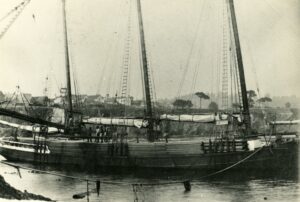What’s a doghole schooner? The standard joke about Mendocino County’s 30 shipping ports 120 years ago was that they were so small and tight a dog getting ready to settle down would have a hard time turning around to settle down. The ships were small with two masts fore and aft and sails, though many were later converted to steam power. They existed to haul finished lumber from mills on the coast to bigger marketplaces and to deliver merchandise to the coast.

Doghole schooners, brigs and barkentine vessels on California’s north coast 120 years were often built by Matt Turner’s shipyards. Why is this interesting? It’s the side story of how and why he became a master shipbuilder that is fascinating.
Born in 1825 and learning his shipbuilding skills on the Great Lakes, Turner arrived in California during the Gold Rush. Earning enough money to return to the Atlantic coast he purchased a ship called the “Taranto” and sailed it around South America to California and engaged in lumber transport. Two years later he sold the vessel, went back East and purchased the “Louis Perry” and sailed it around the Horn to California and went back to hauling lumber. In what became a pattern four years later he was headed east again and brought the brig “Timandra” to San Francisco in 1860.
Ready to do something different, he outfitted the “Timadra” for general cargo transport and took off for Siberia. Becoming ice bound for three weeks near the Amir River his crew fished off the side of the boat and caught BIG fish, later identified as Pacific Cod, and the first ever harvested and sold from the Pacific. Atlantic Cod had been fished from the time of the Vikings, but this was new.
Back to San Francisco, Turner sold the cod, bought 25 tons of salt (for traditional curing of the catch as Salt Cod) and sailed to Sakhalin Island, a Russian island north of Japan, where he caught 20 tons of fish worth $6,000. In 1864 he secured 100 tons of fish, but the word was out, and more and more boats were fishing the area. Turner began developing trade routes in the South Pacific and started planning a shipyard to put his profits to use. In 1875 he opened his first shipyard in San Francisco and proceeded to build 56 exceptionally seaworthy vessels.
He moved his shipyard to Benicia in 1883 and built another 145 vessels through 1902 when he was 77 years of age. He also conducted ship repairs. In 1906 he began building his own yacht, the steam schooner “Hoquiam” and promptly had a stroke and died in 1909.
His specialty was yachts, brigs, and schooners. He built ships for the Hawaiian sugar trade and vessels for the Tahiti packet trade, and a boat for missionaries spreading the word of God in the South Pacific. His biggest yacht, the “Lurline” was built in 1883 for John D. Spreckles, who ran a sugar empire in Hawaii.
Some of the schooners he built that served ports on the Mendocino Coast are listed here. The most noteworthy was the “J. C. Ford” built for the Mendocino Lumber Company in 1882. Three hundred miles east of Honolulu a falling meteor blasted the mainmast and staysail and caught everything on fire. Deck coverings, masts and sails were thrown in the ocean to put flames out, then rescued. The pieces of meteor were said to resemble burning lava. The ship was destroyed in 1893 near Grays Harbor, Washington, when a cargo of lime caught fire when ignited by water seeping into the hold.
Vessels he built were 80 to 90 feet long with two or three masts for sail, and later many were converted to steam engines. The “Kodiak” and “Del Norte” were built in San Francisco, the “Chetco” and “Eureka” were built in Benicia. Many Turner-built schooners, after useful careers as lumber transporters, became canneries. The “Antelope” became a salmon packet and cannery ship and the “Newark,” which used to load firewood at Russian Gulch, became a sardine reduction plant. The “Seven Sisters” stopped often in Point Arena but was crushed by ice near Kotzbue Sound in Alaska in 1906.
If readers would like to learn more about maritime traffic on the Mendocino Coast, they should find a local museum or library and ask to read Walter Jackson’s book, self-published in 1969, called “Doghole Schooners.” The author explores their design, the men who built them, the captains who sailed them, where they wrecked, ports of call, who owned them, and a paragraph about each of almost 300 ships’ adventures. If you want to know the names of the ships who pulled into Whitesboro/Salmon Creek below Albion there are 22 listed and you can look up every ship in this book. It is an amazing book and exciting reading if you love the sea and ships.